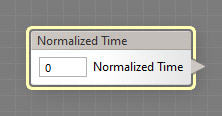
The Normalized Time component outputs the animation time mapped onto the 0...1 range, where the first frame corresponds to 0 and the last frame to 1. The output value of Normalized Time is calculated as a percentage of the current frame of the total number of frames. Normalized Time is most useful when you need your image to be processed in a different way depending on the current percentage of the entire animation duration.
Normalized Time is a numeric component, it can be located in the Animation category on the Components Bar. When Normalized Time is present on the canvas, even if not connected to any component, the filter is considered to be an animated filter.
All copies of Normalized Time in a filter have the same output value. The target inputs interpret the output value differently, depending on their type. The way it is passed to each target input can be fine-tuned with Remappers – see Use Remapping below for details. When Use Remapping is turned off (or when the remapper is set to its default settings), the value is passed as follows:
- To Slider inputs: the Normalized Time range (0 to 100) is proportionally mapped onto the range of the target slider. The resulting value of the target slider is determined by a linear interpolation between its minimum and maximum values, where the interpolation coefficient is defined by the output value of Normalized Time.
- To Color inputs: the Normalized Time range (0 to 100) is mapped onto a black-to-white gradient. The resulting color is determined by a linear interpolation between black and white, where the interpolation coefficient is defined by the output value of Normalized Time.
- To Angle inputs: the Normalized Time range (0 to 100) is proportionally mapped onto the range of 0 to 360 degrees. The resulting angle is determined by a linear interpolation between 0 and 360, where the interpolation coefficient is defined by the output value of Normalized Time.
- To IntSlider inputs: the Normalized Time range (0 to 100) is proportionally mapped onto the range of the target integer slider. The resulting value of the target integer slider is determined by a linear interpolation between its minimum and maximum values, where the interpolation coefficient is defined by the output value of Normalized Time. The result of the interpolation is rounded to an integer number and sent to the target input.
- To List inputs: the Normalized Time range (0 to 100) is proportionally mapped onto the range of the target list. The item number in the target list is determined by a linear interpolation between 1 and the item count of the list, where the interpolation coefficient is defined by the output value of Normalized Time. The result of the interpolation is rounded to an integer number and sent to the target input.
- To Checkbox inputs: if Value is greater than 50 (half the Slider Control range), the target checkbox becomes 'checked', otherwise it stays 'unchecked'.
- To Value inputs: the Normalized Time range (0 to 100) is proportionally mapped onto the range of 0 to 1. The resulting value of the target Value input is determined by a linear interpolation between 0 and 1, where the interpolation coefficient is defined by the output value of Normalized Time.
Use Remapping
When turned on, enables Remappers for all connections of Normalized Time to its target inputs. Remappers allow you to specify how Normalized Time affects the resulting value of each target input.